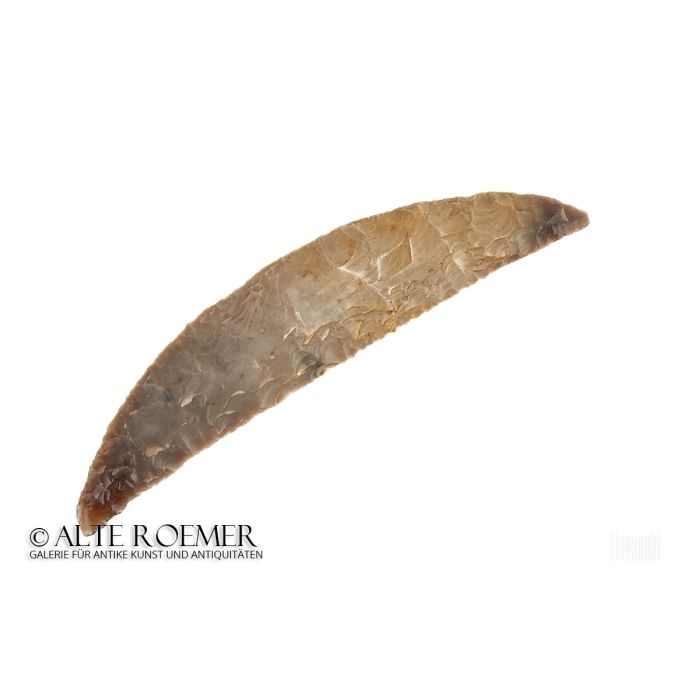Neolithic sickle from Northern Germany
Price: on request
Sold
Object number
AR2626
| Object: |
Neolithic sickle from Northern Germany
|
| Material: |
Grey flint.
|
| Period: |
2400 BC to 1800 BC. Last phase of the Northern European Neolithic. |
| Description: |
Sickle made of beautiful grey flint. The blade is crescent shaped, one side convex the other side straight. The blade is sharp and made of countless flat chips.
|
| Background: |
Many types of crescent-shaped flint sickles occur towards the end of the Neolithic Period. They are based on early copper and bronze prototypes. At first, they were interpreted as saws by archaeologists. Now it is clear they were mounted with the convex side in curved sticks and used as sickles. When the blade became damaged and dull the precious tools were resharped. By that process the blade became increasingly concave and asymmetrical. This piece was appearently not much in use since the edge is still straight. It is remarkable how this tool represents an intermediate state within the radical transition from Neolithic to Bronze Age. |
| Dimensions: |
186mm long, 39mm wide.
|
| Condition: |
Great condition with perfectly preserved and finely worked edges. Inscription in black ink "Lützow S..l…..g 1845".
|
| Provenance: |
Acquired by us in 2018 from the German family collection Warning. Acquired in the collection by Karl Walter Warning between 1905 and 1925, collection no. 14. A hand written list from that time denotes the find spot as Luetzow in Mecklenburg, Germany.
|
| References: |
Cf. P. V. Glob, Danske Oldsager II. Yngre Stenalder, no. 588. Cf. Jeg ser pa oldsager, page 134f, no. 318. Cf. Petersen, Flint fra Danmarks oldtid, page 138f, no. 245. |
| Literature: |
P. V. Glob's classical book Danske Oldsager II. Yngre Stenalder gives a comprehensive overview on the Northern European New Stone Age.
|
| Authenticity: |
We unconditionally guarantee the authenticity of every artefact, all items are subject to our lifetime return policy on authenticity.
|


